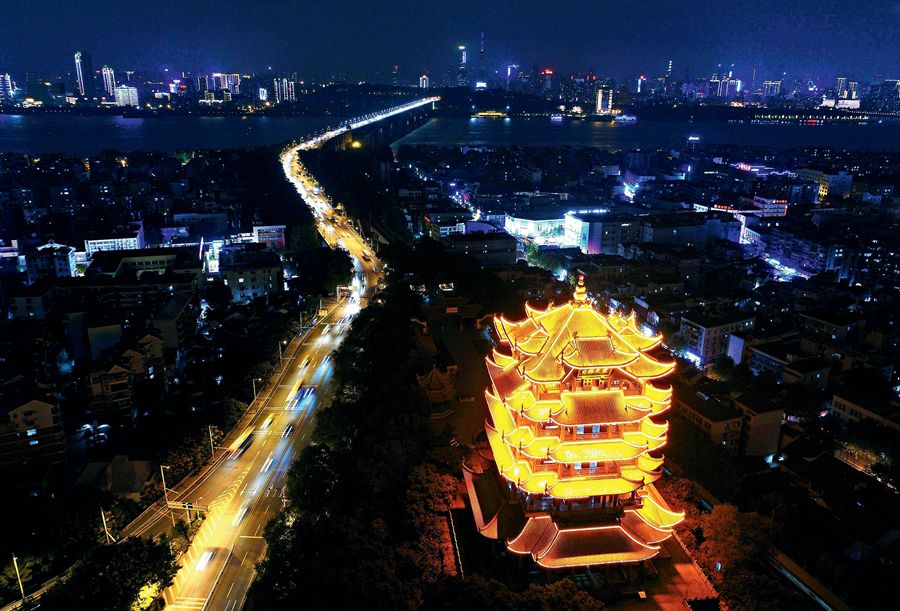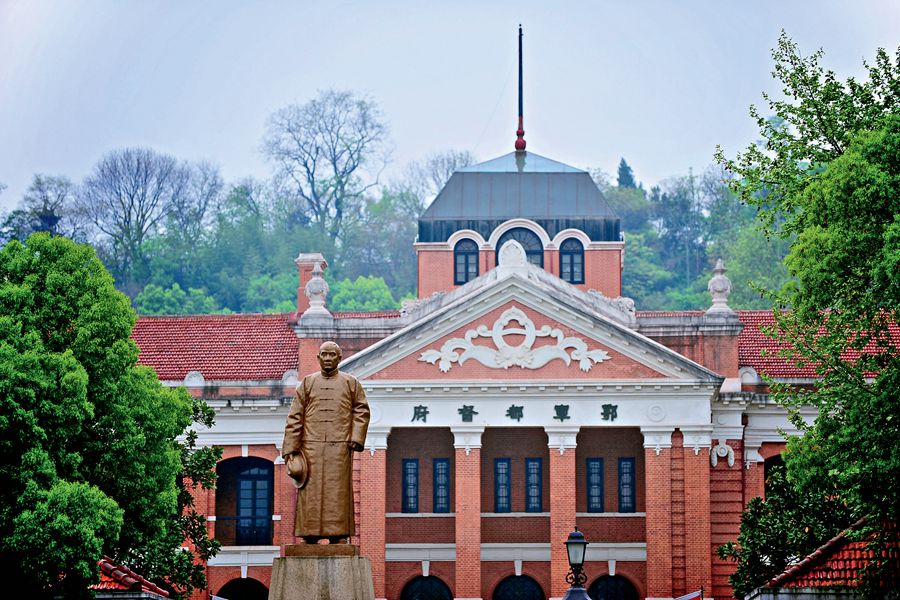WUHAN, the capital city of Hubei Province in central China, lies at the confluence of the Yangtze River, the longest in China, and its longest tributary, the Hanjiang River. These two great waterways split the metropolitan areas into three parts, namely Wuchang, Hankou, and Hanyang. It is also home to China’s largest urban lake: East Lake. With the water taking up one fourth of the total urban area, Wuhan is hailed as a city of lakes.
With a history of 3,500 years, Wuhan is one of the origins of the Chu culture during the Zhou Dynasty (1046-256 BC). Through the Wuchang Uprising, it is also known as the birthplace of the 1911 Revolution. Launched on October 10, 1911, the Wuchang Uprising led to the collapse of China’s 2,000-year-long feudalism and the establishment of the Chinese Republic, the first republic in Asia.

A night view of the Yellow Crane Tower and Wuhan Yangtze River Bridge.
Today, Wuhan is the traffic hub of airlines in central China, and the national center of the high-speed rail network. It is conveniently located to be reached from Beijing, Shanghai, Shenzhen, and Hong Kong in about five hours. Geographically, Wuhan is vital to the national economy. It connects the east to the west, the north to the south and its economy radiates out into the region. And in addition to the bounty of literary masterpieces and cultural heritage sites, the city is also a prosperous modern metropolis.
Origin of the Chu Culture
Originating in the basin of the Yangtze and Han-jiang rivers, the Chu culture is an integral part of Chinese civilization. It got its name because the present Hubei Province was in the territory of the Chu State (1115-223 BC).
When ancestors of the Chu people migrated southward from the Yellow River basin, they brought with them their culture. From this base, the Chu people subsequently absorbed indigenous elements and developed a culture distinct from the states of the northern plains. In the arts, casting techniques of bronze vessels, and music with well-orchestrated eight tones are all valuable cultural heritages from the area that represented the highest level of achievement at that time.

Memorial Hall of the Wuchang Uprising of the 1911 Revolution.
In Suixian County, 200 km northwest of Wuhan, a set of chime bells from the Chu period was excavated from the tomb of Marquis Yi of Zeng (also called “Duke Yi”), who died about 430 BC. It is made up of 65 bronze bells, each of which has twin tones of three intervals and can play independent sounds or harmony. The bells can play melodies in diatonic and pentatonic scales. With its state-of-the-art casting techniques and musical performances, the bells of Marquis Yi changed the history of music and are known as a genuine cultural treasure. The inscriptions on the bells record a monograph of ancient Chinese music theory, which highlights the advanced level of ancient Chinese music.
Driven by the Chu culture, the state of Chu prospered in all respects. Evolving around present Hubei Province, the Chu culture spread to such provinces as Anhui, Hunan, Jiangsu, and Yunnan. In the Southern Song Dynasty (1127-1276), China’s economic center shifted from the north to the south. Since then, Jiangsu and Zhejiang provinces have long been the national economic hub, which is indispensable to the edification of the Chu culture.
Characterized by inclusiveness and openness, the Chu culture absorbed elements of other cultures for its evolution and also shed light on others. This cultural interaction allowed Chinese civilization to flourish for thousands of years.
Wuchang: A Political and Cultural Center
The three parts of Wuhan have distinctive development histories and unique urban functions. As the earliest urban area among the three, Wuchang has been the political and cultural center of Hubei Province, and even the entire central and south China. Hanyang is the earliest hub of China’s military industry, manufacturing the first China-made rifle. Hankou used to be the second largest international metropolis, second only to Shanghai in the early 1900s. It is still the economic and financial center of Wuhan.
The name of Wuchang dates back to 221, when the King of the Wu State moved the capital from Jianye (present Nanjing) to Exian (present Ezhou in the east of Wuhan) and changed its name to Wuchang. Wuchang literally means governing the state with military strength and propelling it to prosper. At that time, Wuchang was called Jiangxia. In the Yuan Dynasty (1271-1368), Jiangxia was upgraded to a provincial administration center, governing regions including Exian. Its name was replaced by Wuchang. Since then, the southern part of Wuhan has remained as Wuchang.
The Wuchang Uprising is an important event in the history of Wuchang. On October 10, 1911, an armed rebellion against the ruling Qing Dynasty broke out in Wuchang. The mutineers established the Hubei military government and spread the uprising quickly across the country. In two months, a total of 15 provinces announced their independence from the Qing government. It was followed by the establishment of the provisional government of the Republic of China in Nanjing on January 1, 1912. Sun Yat-sen was elected as the provisional president. One month later, the abdication of Puyi marked the downfall of the Qing Dynasty and the end of feudalism in China, which lasted for more than 2,000 years.
Today, Wuchang is still the seat of the Hubei provincial government and home to several prestigious national universities. The Yellow Crane Tower, sitting on the Snake Hill in Wuchang, is known as the first tower in China. Literati expressed their sentiments on this historical site and left famous poems and literary works for later generations.
The East Lake in the eastern suburbs of Wuchang is China’s largest urban lake. The lake area boasts of beautiful plum and cherry blossoms from January to April, attracting tourists from across the country.
Hankou: A Commercial Center
Hankou first appears in written history only 500 years ago as it was part of Hanyang. During the early reign of Emperor Chenghua (1465-1470) in the Ming Dynasty, the Hanjiang River changed its course and separated Hankou from Hanyang. Hanyang’s location correspondingly changed from the north bank of the Hanjiang River to the south side.
Hankou has been a commercial city since its inception. Merchants from the upper reaches of the Hanjiang River in Shannxi Province went downstream and distributed cargo throughout China with Hankou as the hub. The convenience of transport on water has helped shape Hankou into a commercial center. In the early 17th century, Hankou emerged as a national transportation hub and the largest inland port.
China-Russia Tea Road, which originated in the middle of the 18th century, started in Hankou and crossed Kyakhta to the hinterland of Russia and Europe. China then dominated 86 percent of world’s tea exports, 60 percent of which came from Hankou port. The congested throng of commercial vessels sailing in and out of the port sometimes lined up for scores of kilometers. As a result, Hankou was hailed by Europeans as a tea port.
After the Opium War, Hankou was opened as a treaty port, welcoming a deluge of foreign investment in trading companies, manufacturing plants, and financial institutions. Hankou began to transform from a traditional commercial center to a modern metropolis. Foreign firms, mainly from the United Kingdom, monopolized shipping on the Yangtze River and foreign trade of agricultural produce like tea. In the first 10 years of the early 20th century, foreign trade in Hankou accounted for around 10 percent of the national total, making it the second largest treaty port in China. Handling about the same volume of foreign trade as Shanghai, Hankou was then the second largest financial center after Shanghai and an industrial and commercial metropolis.
On January 1, 1927, the central government of the Republic of China officially started functioning in Hankou. Wuchang, Hankou, and Hanyang then merged as Wuhan, which was designated as the capital of the country.
The northern bank of the Hanjiang River features Gothic, Rococo, and Baroque buildings in an area of 2.2 square km. It is the remnant of foreign concessions from the 1860s to the first half of the 20th century. From southwest to northeast, there used to be five foreign concessions belonging to the United Kingdom, Russia, France, Germany, and Japan. Today, the consulates of the United States, France, South Korea, and the United Kingdom are also located in Hankou. It is still the commercial and financial center, and the transportation hub of Wuhan, and even the entire central south region of China.
Hanyang: A Place with Artistic Ambience
In Chinese tradition, the north bank of a river is called Yang, therefore because of its location on the north side of the Hanjiang River, it is named Hanyang.
In the late 19th century, Huguang Viceroy Zhang Zhidong, an advocate of Westernization, pushed forward industrialization in Wuhan. He started the Hanyang Iron Works and Hanyang Arsenal, transforming Hanyang into China’s earliest base of steel and armament industries, and in turn boosted Wuhan as a modern industrial city and developed its urban commodities economy. On the riverside from Guishan Mountain to Heshan Mountain lie Hanyang Gunpowder Plant, Hanyang Needle and Nail Plant, and Hanyang Brick Factory, forming an impressive kilometers-long corridor of manufacturing factories. Further boosted by its favorable geographical location and economic status, Wuhan emerged as the prime economic center in this landlocked region of China.
Despite its late establishment, compared with military enterprises in such places as Shanghai and Tianjin, the Hanyang Arsenal was capable of producing the most advanced military equipment at the time. It was the largest military enterprise with state of the art machinery in the late Qing Dynasty. The Type 70 rifle made by Hanyang Arsenal was widely used in the Chinese military for half a century until 1944.
The abandoned workshops of Hanyang Arsenal have been renovated to a modern cultural industrial park – the 824 Art District. Since 2006, artists, sculptors, and photographers have arrived to rent workspaces, and started studios, animation design firms, culture-theme bars, DIY stores, and wedding photography workshops, creating a fledgeling cultural industry. After years of development, the park now is indicative of Wuhan’s cultural industry.
Mottled limestone walls, huge windows, weaving overpasses, impending ventilators, stages, and studios all present an industrial ambience, standing in pointed contrast with random colorful graffiti. Every corner is unique. It is the perfect place to stroll about and enjoy watching the artists at work, and then stopping at one of the many cafes to relax and enjoy the unique ambience.
(Compiled by China Today)

